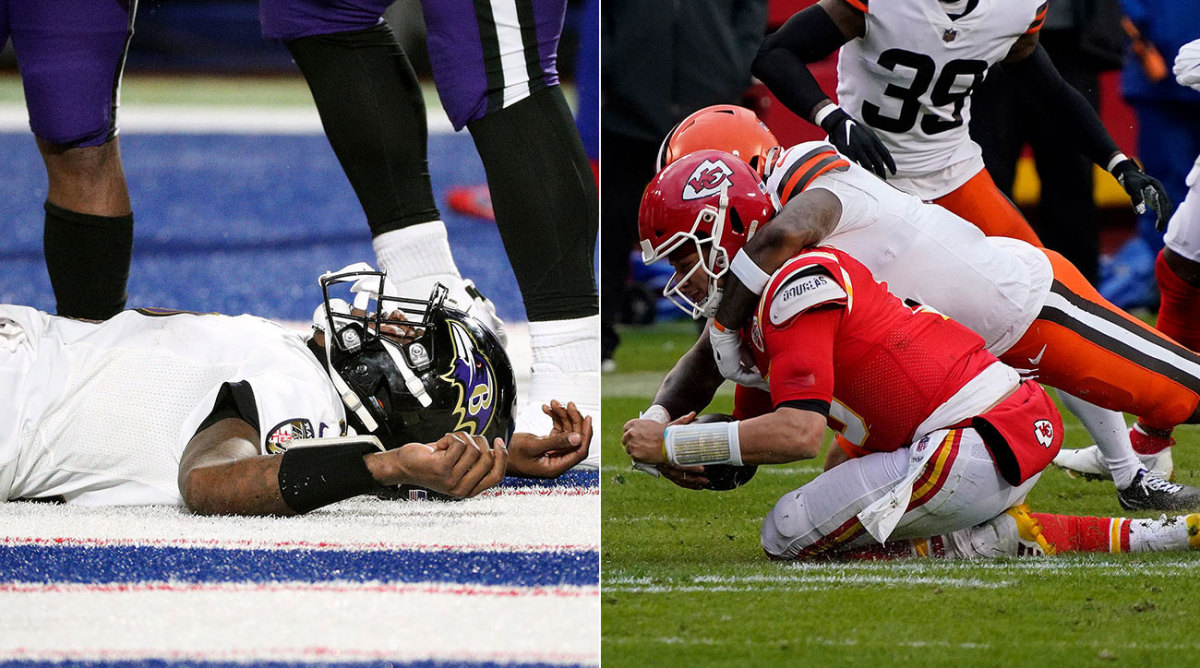The Handling of Lamar Jackson's and Patrick Mahomes's Concussions Shows Progress
There were plenty of times during this COVID-19-ravaged NFL season that the conspiracy enthusiast in all of us (maybe by saying enthusiast we can draw a line between us and the theorists, who are far more dangerous at the moment?) gleefully pointed out instances where it seemed the league was relaxing its protocol standards in order to move along with the season unscathed from a scheduling standpoint.
It’s easy to view these instances as part of our (not totally unfounded) narrative, that the league is a cold monolith with no concern for its employees, without also considering that something truly stunning about the divisional round this weekend points to the contrary; something that would never have occurred 10 or even five years ago.
During critical stretches of playoff football, two of the league’s brightest young star quarterbacks—Lamar Jackson and Patrick Mahomes—needed to be evaluated for concussions and were shown able to jog off the field under their own power, and neither of them returned to the game. The severe optics of Mahomes’s injury, which included him wobbling to his feet, expressionless as he tried to gain his physical bearings, likely made any decision behind closed doors that much easier. But there is little doubt both wanted to return to play, and little doubt the league, at least in a prior era, would have rubbed its greasy hands together at the prospect of Jackson storming back down the field again for a last-second comeback attempt or Mahomes galloping onto the field from the locker room to save the Chiefs from the brink of elimination.

The NFL’s approach to injury prevention is far from perfect, but perhaps we might consider this weekend a significant benchmark in how we police head injuries in the NFL and how we all understand our role in perpetuating the machismo, hero culture that compounded so many of these head injuries in the past. Most of us watched Mahomes’s eyes darting around inside the blue medical tent and thought, Good Lord, let’s hope we don’t see him again today.
It wasn’t that long ago that concussions were not something that regularly kept players out of games. It wasn’t that long ago that concussions were known by their cute nicknames like bell ringers and “seeing stars.” It was five—five!—years ago that Case Keenum had his head slammed off the turf, struggled to prop himself up on his knees and got to remain in the game, which eventually triggered an NFLPA investigation. It was two years ago that Mason Rudolph was knocked unconscious live on our television against the Ravens, carried off the field on a stretcher when the medical cart wouldn’t work.
Hell, it was during the Browns-Chiefs game on Sunday when Daniel Sorensen torpedoed Browns receiver Rashard Higgins helmet-to-helmet (a foul that, for some strange reason was not called), which caused an infamous fumble-through-the-end-zone touchback that quickly had most people debating how silly the touchback rule was.
But in both cases, Jackson and Mahomes, two of the league’s most important players, the faces of the NFL’s future, were sidelined with head injuries that were taken seriously while the biggest audiences of the season were tuned in.
None of this is going to make life better for the former players who suffered in silence for years, afraid to even bring up the prospect of a head injury in front of authority figures. None of this, certainly not watching Mahomes on Sunday, is going to ease the understandable concerns of parents watching and debating whether their sons and daughters should be allowed to play football. None of this should make us forget the ethical tradeoff we all make in popularizing and deifying this sport and its participants.
What this does, though, is strengthen a precedent in the making. It does normalize the identification and attempted mitigation of head injuries. It lessens the power of seething coaches and fans who see the participants as nothing but a means for their own personal enjoyment or gain (a class in our game and society that is hopefully shrinking).
During the broadcast, CBS’s Jim Nantz said: “If that’s not a concussion, I don’t know what one is.” Twenty years ago, it would have been part of Dennis Miller’s in-game comedy bit as we watched the quarterback hobble his way back onto the field because that’s what tough guys do, especially in the big game. Shouldn’t we score that a win, even if it doesn’t exactly feel like one?
